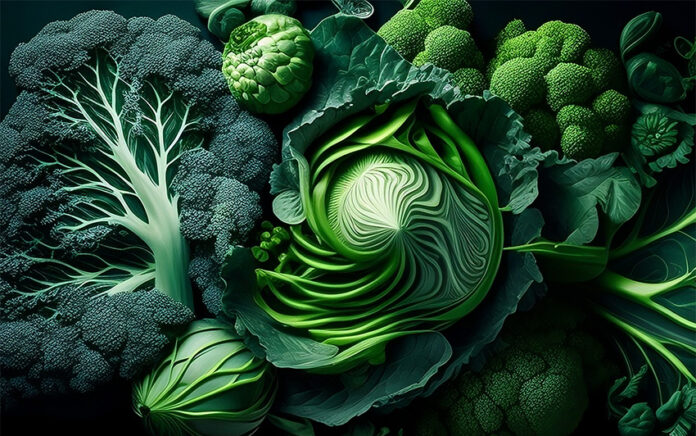MOST NITRATES COME FROM VEGGIES
Nitrates and Nitrites are important nitrogen compounds that play a vital role in the growth and well-being of plants and animals. They exist naturally in the environment, including in soil, water, and air. Interestingly, our own bodies also produce Nitrates and Nitrites.
In various industries, Nitrates are commonly used as fertilisers for promoting healthy crop growth and maintaining lush lawns. Furthermore, both Nitrates and Nitrites have diverse applications, such as preserving food and formulating certain pharmaceutical drugs.
These compounds consist of Nitrogen and Oxygen. Nitrates (NO3-) have three Oxygen atoms bonded with Nitrogen, whereas Nitrites (NO2-) have two Oxygen atoms bonded with Nitrogen. These substances are commonly used as legal preservatives in bacon, ham, salami, and certain types of cheeses. They also effectively inhibit the growth of harmful bacteria.
Despite the widespread concern surrounding processed meat, it might be surprising to learn that it only accounts for approximately 6% of the Nitrates in the typical Western diet. In contrast, over 80% of dietary Nitrates originate from vegetables. Vegetables absorb Nitrates and Nitrites from the soil in which they are cultivated. Nitrates are naturally present in mineral deposits within the soil, while Nitrites are formed through the breakdown of animal matter by soil microorganisms.
Leafy greens such as spinach and kale are commonly known for their high Nitrate content, though when it comes to organic vegetables, they may actually contain lower levels of Nitrates compared to non-organic ones since synthetic Nitrate fertilisers are not used in organic farming practices.
The key difference
There is a significant distinction in the packaging of Nitrates and Nitrites between meat and vegetables, and it’s this distinction that affects their potential carcinogenic properties. Nitrates, on their own, are relatively stable substances and are unlikely to engage in chemical reactions within the body. However, Nitrites and the resulting chemicals derived from them are much more reactive.
Most of the Nitrites we encounter are not directly consumed but are converted from Nitrates by bacteria present in our mouth due to a natural biochemical process.
Nitrates enter our body through the digestive system. In the mouth, certain types of bacteria, particularly those found on the surface of our tongues and in plaque, can convert nitrates into nitrites through a process called Nitrate reduction. This conversion occurs due to the activity of specific enzymes produced by these bacteria. Once Nitrites are formed, they can undergo further transformations in the stomach and other parts of the digestive system. In the stomach’s acidic environment, Nitrites can react with stomach acids to form Nitric Oxide (NO) and other reactive nitrogen species, which we’ll go into a bit later.
The conversion of Nitrates to Nitrites by oral bacteria and subsequent reactions within the body is part of a complex process known as Enterosalivary Circulation. This process involves the recycling of Nitrates and Nitrites between the oral cavity, the digestive system, and the circulatory system.
It’s important to note that Nitrites themselves can have potentially harmful effects when present in high concentrations or in certain circumstances. For example, when Nitrites react with amines or amides in the presence of heat, such as when bacon or sausages are fried, they can form Nitrosamines. It’s these ‘Nitrosamines’ that have been identified as carcinogens and have been associated with colorectal cancer.
It isn’t so much that Nitrates/Nitrites are bad or highly carcinogenic. We must factor in the way Nitrates are cooked and their local environment. For instance, in processed meats, Nitrites are in close contact with proteins, particularly Amino Acids.

When these meats are cooked at high temperatures, this proximity promotes the formation of carcinogenic Nitrosamine compounds. It’s also important that we don’t single out Nitrosamines as the main culprit of colorectal cancer, though, in relation to the consumption of processed meats. Other factors that may play a role, include the presence of iron, the formation of PAHs (polycyclic aromatic hydrocarbons) during the smoking of meats, and the generation of HCAs (heterocyclic amines) when meat is cooked over an open flame. These substances have also been linked to promoting tumour growth.
The Whole package
It is widely accepted that Nitrates in leafy greens are unlikely to pose significant harm, particularly in the formation of Nitrosamines. One of the reasons is that leafy greens are not considered protein-rich foods. Moreover, they contain beneficial elements like vitamin C, polyphenols, and fibre, which have all demonstrated their ability to lower the formation of Nitrosamines. So, including leafy greens in our diet can be seen as a positive choice, as they come with protective components that help reduce the risk of Nitrosamine formation.
Increasing evidence also concludes that Nitrites can provide cardiovascular and other benefits due to the presence of Nitric Oxide, an important signalling molecule.
In 1998, three American scientists were honoured with the Nobel Prize for their remarkable contributions in uncovering the role of Nitric Oxide, a gas, in the cardiovascular system. Subsequent research has revealed that Nitric Oxide plays a vital role in vasodilation, lowering blood pressure, and acting as a defence mechanism against infections. Impaired Nitric Oxide production has been associated with conditions like heart disease, diabetes, and erectile dysfunction.
The body produces Nitric Oxide through various mechanisms, including the conversion of a particular amino acid called Arginine, which serves as a building block for proteins. However, it has been discovered that dietary Nitrates also play a significant role in the production of Nitric Oxide. This becomes particularly important for older individuals, as natural Nitric Oxide production through Arginine tends to decline with age. Therefore, the consumption of dietary Nitrates becomes increasingly valuable in supporting Nitric Oxide formation, especially in older individuals.
It’s fascinating to consider that the Nitrates from processed meats are chemically identical to the Nitrates from fruit and vegetables, and yet the Nitrates in our diet sourced from vegetables, instead promote the formation of Nitric Oxide. In fact, a renowned expert in Nitric Oxide has taken this concept even further by suggesting that many individuals may have a deficiency in Nitrates and Nitrites. This expert proposes that these compounds should be recognised as essential nutrients that can play a crucial role in preventing conditions like heart attacks and strokes. It’s intriguing to consider the potential significance of Nitrates and Nitrites in maintaining our overall well-being.
The bottom line? If you’re aiming to consume the beneficial types of Nitrates and Nitrites while steering clear of potentially carcinogenic ones, here’s what you can do: embrace a wonderfully diverse diet that includes at least 30 different types of fruits and vegetables each week, and try to limit (or better yet, eliminate altogether) your consumption of processed meats. By doing so, the advantages of Nitrates and Nitrites are far more likely to outweigh any potential drawbacks.






